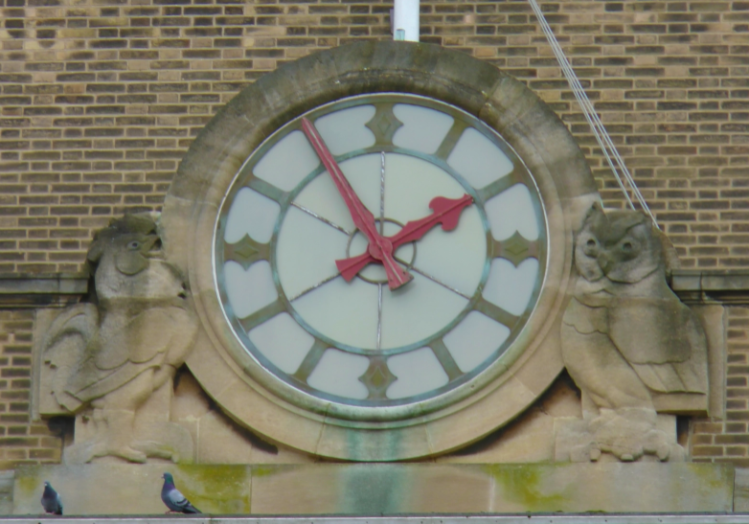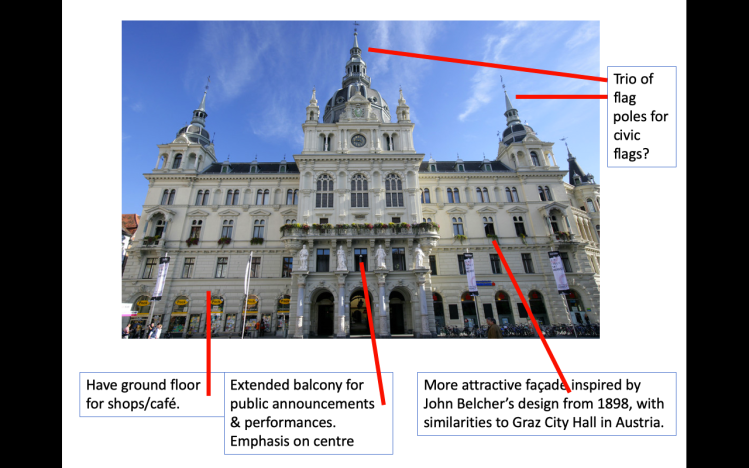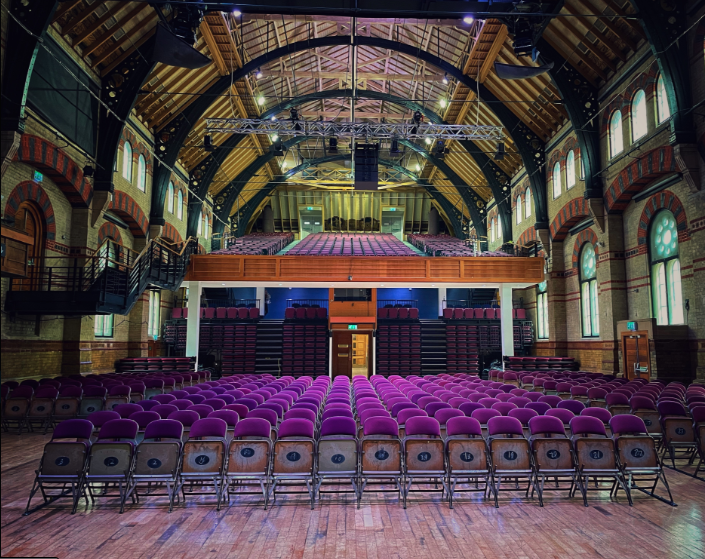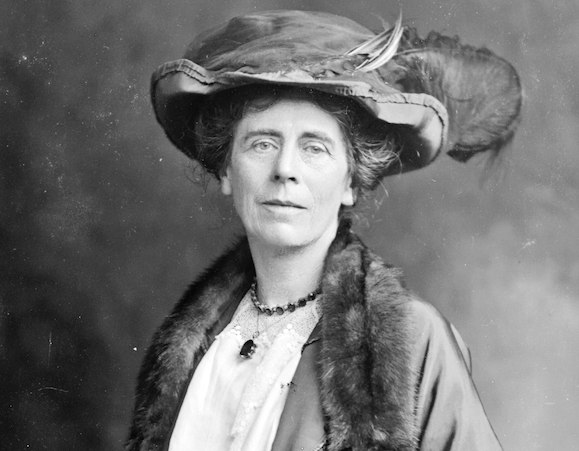Cambridge City Council proposes allocating significant funding to give the Guildhall a much-needed overhaul (old buildings eventually need big maintenance programmes – and this one is nearly 90 years old)
TL/DR? Please ask your councillors if we can use this as a starting point on revamping our guildhall.
Talking of the guildhall, anyone wondering what the Cambridge Town Owl is or where the name comes from, next time you’re in Cambridge Market Square, have a look up at the clock…

…and it was former Mayor of Cambridge Florence Ada Keynes who got the current guildhall built after nearly a century of squabbles between the previously all-male councils!
If there’s one historical figure that did more to shape the city of Cambridge than any other local person over the last century or so, it’s Florence Ada Keynes – The Mother of Modern Cambridge. Male economists may recognise her as ‘Oh! John Maynard’s Mum!’ and elder Dons (the chaps) at The University might recognise her as ‘Neville’s wife’ but to those of us who are interested in the history and people of ‘town’, Florence Ada Keynes is a figure of huge historical and civic importance.
Above – don’t just take my word for it! Former Cllr Hilary Cox Condron at the Cambridge Corn Exchange
Which is why it’s a shame that there’s so little that commemorates her work and life in Cambridge – the place where she spent almost her entire adulthood – almost three-quarters of a century – in Cambridge following her arrival at Newnham College in the late 1870s. Hence my repeated calls for a new concert hall named after her to be built on the site opposite her home on Harvey Road.
A city of quarters

That title comes from a publication from the Young Advisory Committee of Cambridge Ahead – which I blogged about here. Written by a group of professionals under-35, the full report is worth a read here – not least because the authors ask some very difficult questions of senior decision makers in a host of institutions. Journalist Mark Williamson has started a list of proposed quarters of Cambridge given the number that have been mentioned by various institutions.
Above – CB1 and Eddington – two of the ‘architecturally controversial’ areas sometimes described as quarters, with some of you asking if there are only allowed to be four quarters and if so, who gets to decide which four they should be.
The Civic Quarter as proposed by Cambridge City Council
Cambridge Independent columnist Phil Rodgers spotted the item.
“Civic Quarter Development Reserve £20m: A new earmarked reserve is proposed, with the remit to provide funding for work required to design and develop a new civic quarter in the centre of Cambridge, comprising the Guildhall, Market Square and Corn Exchange.”
Cambridge City Council S&R Papers Item 6 BSR paper p12
***Twenty-million smackeroonies?!?!***
Don’t get excited. We found out earlier at the Greater Cambridge Partnership Board Meeting that you’ll get little change from £1million from revamping a crossroads in the city centre. Twenty-mill won’t go as far as people think it will.
Above – former Petersfield Councillor Frank Gawthrop (Lab – Petersfield 1978-89) giving the hard facts to GCP Board Members earlier this afternoon regarding the controversial revamp so soon after the last one.
Can the Guildhall be revamped to increase trading revenue?
Much as I think it should be the heart of a thriving local government function, the short-medium term political realities in Westminster mean that we are where we are. Which is why ages ago I started thinking what a revamped guildhall might look like – finally getting round to putting something in writing back in 2022 here

Above – my proposals for increasing the number of large meeting rooms and creating a state-of-the-art lecture hall/conference space that could be rented out to paying customers and booking organisations

Above – inspiration from Graz City Hall in Austria (which I visited back in the mid-2000s) that provide for a nice template of what a revamped guildhall front could be like – simply built in front of the existing frontage.
It would not necessarily require the removal of the existing stone and brickwork. Note that the main building itself is built on and around a steel frame.
“The £20million has to cover the Corn Exchange too”
This is a longstanding issue that dates back to the 1960s and Gordon Logie’s proposals for a new large concert hall for Cambridge. The collapse of those proposals resulted in city councillors deciding in the 1980s to convert the otherwise large empty interior of the Corn Exchange into a concert hall. It was the most cost-effective decision for its time, but inevitably meant compromising on both capacity and acoustic performance as I’ve found out the hard way both as a chorus performer (around 50s in – me in the black shirt & red tie!), spectator, and amateur camera person/video editor.
Yet the interior of the building shows that the spacious interior can be sub-divided horizontally to create two to three separate floors

Above – from the Corn Exchange’s Twitter handle – you can see how the additional seating above, installed in the 1980s to enable the creation of an entrance hall, fits in.
That leaves enough space for a possible indoor market on the ground floor (that has been a popular call), through to creating a large top-floor gallery for performances, club nights, and exercise classes.
‘We found out that Victorian-style charity doesn’t work back in Victorian times’
And we also found out the hard way that American-style philanthropy also does not work – even in a city like Cambridge with all of its wealthy firms and booming industries. City councillors have told me in responses to several public questions over the years (eg on a permanent capital fund here) that for all of the positive noises, when it comes to coughing up the cash, the corporate wallets are empty.
Hence why I believe it’s essential that councillors make the case to ministers and shadow ministers for an empowered local government sector for Cambridge (however they define it – from 1930s-era boundaries to the much wider economic sub-region) to tax the wealth and land-value-uplifts being generated here to pay for the much-needed infrastructure – civic, social, environmental, transport, housing, public services, and so on. Otherwise we’ll continue down the road of private opulence, public squalor. Our city must become better than this. We cannot be in the business of repeatedly going cap-in-hand to ministers.
And given that the Levelling Up Secretary name-checked concert halls and museums…
“Mr Gove outlined his Cambridge 2040 vision as “a new urban quarter, one truly plugged in to the existing city, rather than simply orbiting it, with beautiful new classical buildings, rich parkland, concert halls and museums providing new homes for thousands each year”.”
BBC Cambridgeshire 19 Dec 2023
…exactly.
“Has the Secretary of State been reading this blog?”
Only I can’t think of many other people who have been going on about things like concert halls (here’s me on a new North Cambridge Arts Centre) and museums (here’s me on expanding the number and size of local museums).
In which case there’s a challenge for shadow ministers on ensuring any expansion of Cambridge makes up for the existing infrastructure deficit (highlighted by Dr Andy Williams, formerly of Astra Zeneca to Queen Edith’s residents last year) *and* covers the future infrastructure needs.
And finally…Local Elections 2024
The news today reported on the Prime Minister’s remarks on a general election date, indicating it won’t be at the same time as the local elections 2024. Hence people can contact their local councillors (https://www.writetothem.com/) if they have any thoughts on the civic quarter (even if they are in opposition to it).
Food for thought?
If you are interested in the longer term future of Cambridge, and on what happens at the local democracy meetings where decisions are made, feel free to:
- Follow me on Twitter
- Like my Facebook page
- Consider a small donation to help fund my continued research and reporting on local democracy in and around Cambridge.

